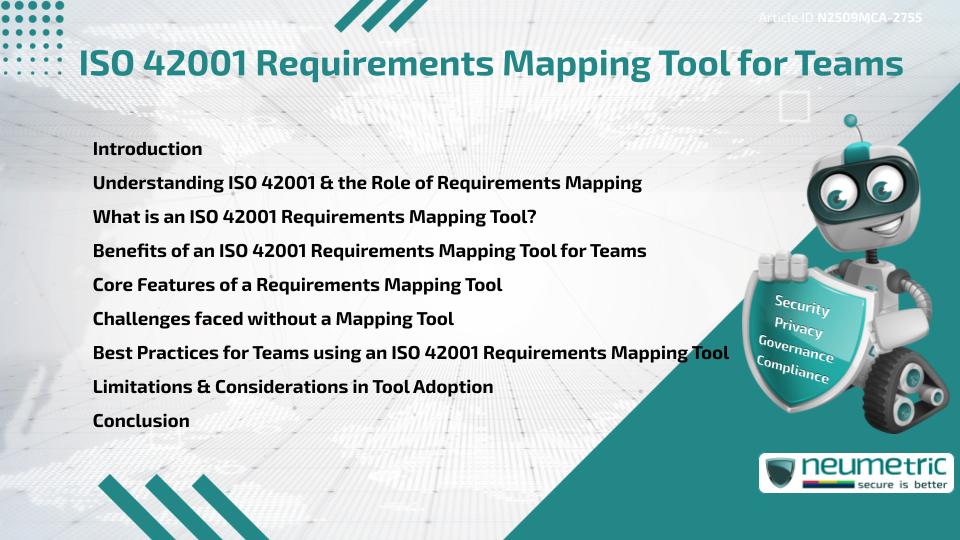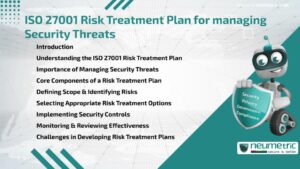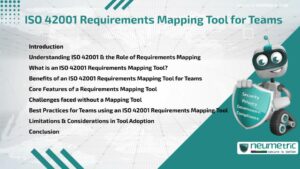Table of Contents
ToggleIntroduction
An ISO 42001 Requirements Mapping Tool helps Teams link Compliance tasks directly to the Clauses & Expectations of ISO 42001. This ensures that Organisations can track progress, identify Gaps & maintain consistency across Departments. By using such a Tool, Teams streamline Audit preparation, avoid duplication of efforts & reduce Risks of Non-Compliance. Without it, Firms often face confusion, delays & incomplete Compliance coverage. This article explores the purpose, benefits, features, challenges & best practices of adopting an ISO 42001 Requirements Mapping Tool for Teams.
Understanding ISO 42001 & the Role of Requirements Mapping
ISO 42001 is a Global Standard that provides structured requirements for establishing & maintaining Compliance Systems. For Teams, the challenge lies in translating these broad requirements into day-to-day responsibilities. Requirements mapping provides the missing link by showing how each Clause applies to Policies, procedures & roles within the Organisation. It acts as a Roadmap, making the Standard more practical & accessible.
For more details, see the International organisation for Standardisation.
What is an ISO 42001 Requirements Mapping Tool?
An ISO 42001 Requirements Mapping Tool is a digital platform that helps Teams match ISO 42001 Clauses to Organisational Processes. It acts as a central repository where Compliance activities, Evidence & responsibilities are organised. By creating a clear map, Teams can ensure they cover every requirement without overlap or omission.
Benefits of an ISO 42001 Requirements Mapping Tool for Teams
Using an ISO 42001 Requirements Mapping Tool offers several advantages:
- Efficiency: Saves time by providing structured links between Requirements & Tasks.
- Clarity: Helps staff understand how their roles connect to Compliance.
- Risk reduction: Minimises chances of missing critical Clauses during Audits.
- Collaboration: Promotes teamwork by centralising Compliance activities.
- Audit readiness: Creates transparent Records that Auditors can easily review.
Core Features of a Requirements Mapping Tool
An effective ISO 42001 Requirements Mapping Tool should include:
- Clause-to-task mapping functionality
- Centralised Document & Evidence repository
- Real-time Dashboards showing progress
- Role-based Access for Teams & Managers
- Automated Alerts for pending or overdue tasks
- Exportable Reports for Audit purposes
Challenges faced without a Mapping Tool
Teams without a Mapping Tool often struggle with:
- Disconnected Processes leading to Duplication of efforts
- Lack of visibility into overall Compliance progress
- Higher Risk of overlooking specific ISO 42001 Clauses
- Difficulty in preparing for External Audits
- Miscommunication between Departments
These issues can delay Certification & erode confidence in Compliance management.
Best Practices for Teams using an ISO 42001 Requirements Mapping Tool
To maximise value, Teams should:
- Customise the Tool to reflect Organisational Workflows
- Train Staff on how to use the mapping features effectively
- Keep Documentation updated & linked to relevant Clauses
- Use Dashboards for regular Compliance reviews
- Involve Auditors early to ensure mapping aligns with Expectations
Limitations & Considerations in Tool Adoption
Although an ISO 42001 Requirements Mapping Tool brings clarity & structure, it cannot replace strong Governance & Staff accountability. Tools require regular updates to remain effective & over-reliance on automation may cause Teams to miss nuances in requirements. Firms must balance Technology with Human oversight to ensure Compliance integrity.
Conclusion
An ISO 42001 Requirements Mapping Tool helps Teams translate ISO 42001 Clauses into actionable tasks, making Compliance management structured & reliable. By improving clarity, efficiency & Audit readiness, these Tools become indispensable for Firms aiming for Certification success.
Takeaways
- An ISO 42001 Requirements Mapping Tool links Clauses to Organisational tasks.
- It improves efficiency, clarity & collaboration across Teams.
- Without it, Firms Risk Duplication, Confusion & Missed requirements.
- Best Practices include customisation, training & regular reviews.
- Tools must complement, not replace, strong Compliance Governance.
FAQ
What is an ISO 42001 Requirements Mapping Tool?
It is a digital platform that links ISO 42001 Clauses to Organisational Processes, ensuring full Compliance coverage.
Why do Teams need a Mapping Tool?
It helps prevent Duplication, improves Clarity & ensures Audit readiness by mapping requirements to tasks.
What Features should the Tool include?
Key features include Clause-to-task mapping, Dashboards, Evidence repositories & automated Alerts.
Can Compliance be managed without a Mapping Tool?
Yes, but it becomes more Time-consuming, Error-prone & harder to sustain across Teams.
How does the Tool improve collaboration?
It centralises Compliance activities, making Roles & Responsibilities transparent to all Team members.
Does using the Tool guarantee Certification?
No, Certification depends on how well the Organisation implements ISO 42001 requirements, but the Tool simplifies the journey.
What are the Risks of over-relying on the Tool?
Over-reliance may cause Teams to miss contextual nuances, making Human oversight & Governance essential.
Need help for Security, Privacy, Governance & VAPT?
Neumetric provides organisations the necessary help to achieve their Cybersecurity, Compliance, Governance, Privacy, Certifications & Pentesting needs.
Organisations & Businesses, specifically those which provide SaaS & AI Solutions in the Fintech, BFSI & other regulated sectors, usually need a Cybersecurity Partner for meeting & maintaining the ongoing Security & Privacy needs & requirements of their Enterprise Clients & Privacy conscious Customers.
SOC 2, ISO 27001, ISO 42001, NIST, HIPAA, HECVAT, EU GDPR are some of the Frameworks that are served by Fusion – a SaaS, multimodular, multitenant, centralised, automated, Cybersecurity & Compliance Management system.
Neumetric also provides Expert Services for technical security which covers VAPT for Web Applications, APIs, iOS & Android Mobile Apps, Security Testing for AWS & other Cloud Environments & Cloud Infrastructure & other similar scopes.
Reach out to us by Email or filling out the Contact Form…





